Far from grotesque, Rhacodactylus auriculatus can be a great addition to a home.
Among the many reptiles that make good pets, few are as hardy, long-lived, personable and rewarding as a gargoyle gecko (Rhacodactylus auriculatus). With a little guidance, even people without reptilekeeping experience can have great success with these geckos.
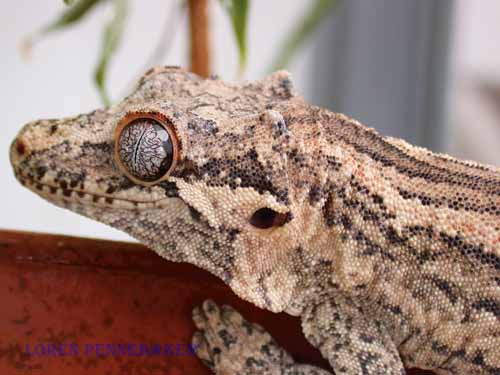
Photo by Loren Pennebaker
With a little guidance, even people without reptilekeeping experience can have great success with these geckos.
There are several reasons why. First, gargoyle geckos come from New Caledonia, a large island about a 1,000 miles east of Australia. The island enjoys a relatively mild climate year round. Even during the warmer season, temperatures rarely exceed 80 degrees Fahrenheit. As a result, gargoyle geckos prefer mild temperatures. Second, as nocturnal lizards, they don’t have the special lighting or heating requirements many reptiles need for good health. Third, though these geckos readily climb many surfaces, they are not particularly quick and usually can be captured without difficulty. Coupled with their amazing resilience to stress, this makes gargoyle geckos relatively easy to handle and train. They might be the perfect pet gecko.
If given the proper care, these geckos may live longer than 15 years. Thanks to dietary advances it’s possible that they could live more than 20 years.
Arboreal Dwellings
In many ways gargoyle geckos can be kept in conditions identical to crested geckos. Unlike their famous crested cousins, gargoyles are normally anti-social, so they shouldn’t be housed together except on a limited basis. If gargoyles are forced to live together, social stress and fighting are usually inevitable and can result in severe trauma. Unless breeding them, house gargoyles individually.
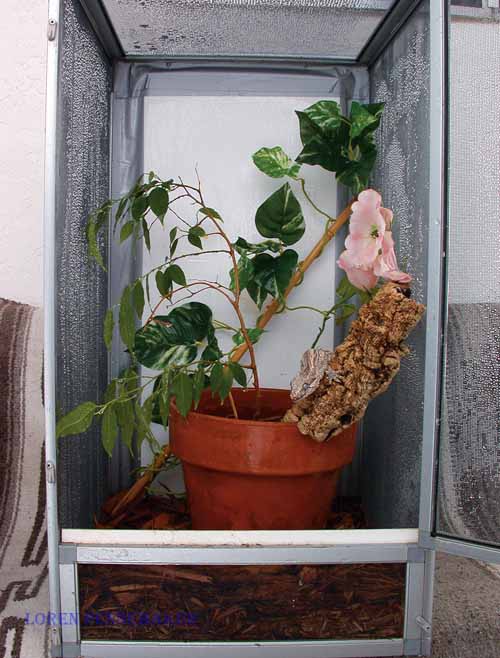
Photo by Loren Pennebaker
Gargoyles can be kept in vertical habitats, such as this all-screen enclosure with live and fake plants.
I recommend an enclosure at least 24 inches long, 12 inches wide and 17 inches tall. It’s commonly referred to as a 20-gallon high. Gargoyles have strong arboreal tendencies and appreciate vertical space. An alternative is a vertically oriented enclosure at least 16 inches long, 16 inches wide and 24 inches tall. Give your gargoyles as much space as possible. I believe the geckos generally reward such a choice by being healthier and more content.
Gargoyles can be kept in either glass or all-screen enclosures. Glass enclosures are the frequent choice. Although some consider them more attractive for naturalistic vivariums, glass costs more than screen. Providing large glass enclosures for a gargoyle can get expensive. In addition, most glass enclosures don’t have good ventilation, and based on my observations, gargoyle geckos, which have a good sense of smell and taste, tend to be healthier and more content in well-ventilated environments.
For the health and happiness of your gargoyle, I recommend screen enclosures. They tend to be less expensive than glass enclosures and thereby provide more space for less money. The screen sides provide superior ventilation, and they also provide additional surfaces for water droplets to form during misting. As my gargoyles patrol their enclosure at night, they routinely drink these water droplets, which often remain for several hours after the initial misting.
Grand Furnishings
Several types of substrate are functional for gargoyle geckos. Many people choose something simple such as paper towels. Because I prefer naturalistic enclosures and rely on frequent misting, I keep all my gargoyles on a soil mix topped with cypress mulch.
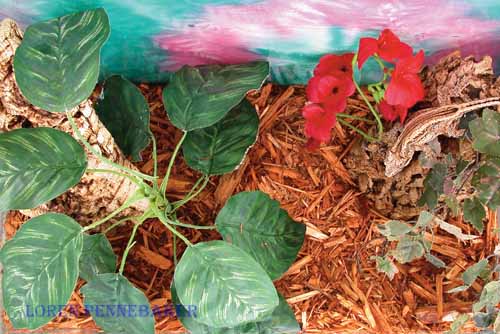
Photo by Loren Pennebaker
Gargoyles are quite anti-social, so house them separately whenever possible.
To make this substrate, I mix equal parts of coconut fiber and chemical- and pesticide-free potting soil, and then I cover the enclosure bottom with 2 to 3 inches of this mix. Coconut fiber absorbs and retains water effectively, and potting soil makes the mix more natural and functional for digging and egg deposition. For best results, I recommend stirring the layers of soil regularly. It evenly distributes the moist layers and keeps the soil from developing excess bacteria and mold. Lastly I add 1 to 2 inches of cypress mulch on top of the soil mix. This layer dries quickly and allows lower levels of substrate to retain moisture without having the top layer of substrate consistently saturated. Also, because the surface layer is where most fecal matter ends up, it’s easy to keep the enclosure relatively clean by simply replacing the cypress mulch regularly.
It may seem counterintuitive, but cypress mulch actually helps prevent impaction. Gargoyles seem much more likely to accidentally ingest soil than cypress mulch. After nine years of using this mulch for my geckos, I have not had one confirmed case of impaction from the mulch.
Like most geckos, gargoyles are nocturnal, and they seek out secure hiding places to sleep during the day. To ensure that the gecko feels secure, provide adequate cover by properly landscaping its enclosure. Creating cover and hiding places is normally achieved through strategic placement of plants and branches, which can be either live or fake.
Many people prefer to use real plants. When using them, I have had great success with a couple Ficus species. With its huge, sturdy leaves, the fiddle-leaf fig (Ficus lyrata) seems to be the favorite plant among my geckos. Golden king ficus and Ficus benjamina are also good choices. When using live plants, consider the need for additional lighting and space because most plants won’t live long in a gecko enclosure without supplemental lighting and extra room. Using live plants can often complicate matters, so it’s an option best left for experienced geckokeepers.
Fake plants, vines and flowers are attractive, easy-to-clean alternatives. Those with large, broad leaves provide the most cover. Fake vines and flowers add variety and color to the enclosure. Cork bark and dried grapevine branches provide good climbing surfaces. Make sure any heavy branches are secure, so they cannot fall and injure the gecko. Cork bark can be leaned against the sides of the enclosure to create hiding places, and it’s usually too light to cause any injury in the event of a collapse.
Although it’s good to have several surfaces in the enclosure to catch water during misting, it is equally important to ensure that the cage has open space and does not become crowded.
Mind the Ambience
It’s imperative to closely monitor the temperatures in the enclosure, especially during warm seasons or if providing a heat source. Gargoyle geckos prefer temperatures in the 70s. They tolerate temperatures down into the 50s for limited periods of time. They become uncomfortable and stressed when temperatures exceed 85 degrees, and extended periods of high temperatures can be lethal. Various types of thermometers adequately measure temperatures. I use a temp gun for accuracy and versatility.
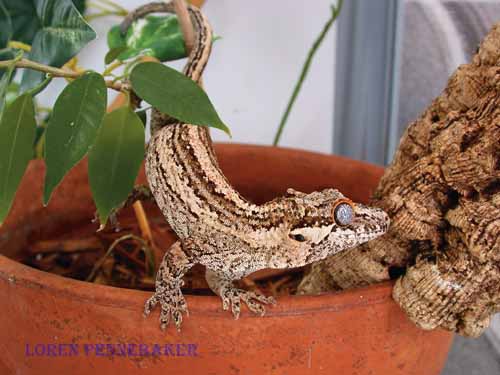
Photo by Loren Pennebaker
Gargoyle geckos seem to have an amazing resilience to stress.
A 12-hour photoperiod is fine for gargoyles. In general, a heat source really isn’t necessary, and it can actually be dangerous. Low-wattage fluorescent lights are the only heat source I provide my geckos. Any incandescent heat source should be the lowest wattage possible, and closely monitor it. If temperatures above 85 degrees cannot be avoided, frequent misting with cool water is the best way to avoid overheating.
Gargoyle geckos tolerate dry conditions better than other Rhacodactylus species, but they still require clean drinking water daily to maintain proper hydration. Although older gargoyles learn to find and drink water from a dish, misting the enclosure is usually the primary watering method. For best results, use filtered or distilled water warmed to room temperature. A spray bottle set on a fine mist efficiently dispenses the water.
Upon being sprayed, gargoyles drink water off themselves and any other surface they find droplets. Fake or real plants within the enclosure provide additional surfaces to hold droplets. Screens also hold water droplets well. Gargoyles can often be found hanging upside down on the screens of glass enclosures drinking these droplets.
Mistings should never stop, but once a gargoyle has matured and has grown accustomed to finding its fruity gecko diet concoctions, a water dish can be added to the enclosure. Make sure to check and clean the dish each day because gargoyles often defecate in food and water dishes.
Gargoyles seem to prefer humid conditions, but they don’t necessarily require high humidity for proper hydration. Humidity levels 60 to 90 percent are ideal.
However, these levels aren’t realistic for many people who live in dry environments, including me. I use large humidifiers in my Rhacodactylus rooms, but I rarely see humidity levels above 50 percent. I have found that as long as I mist one to two times daily, humidity levels are unimportant. Substantial layers of absorbent substrate become critical if hot or dry conditions necessitate frequent misting. Yet make sure not to overwater the enclosure. It leads to swampy conditions that promote excessive mold and bacteria. Also never compromise ventilation for the sake of humidity levels.
Steady Omnivores
Gargoyle geckos eat many different things if the opportunity arises. According to various studies by Aaron Bauer, wild gargoyles eat flowers, pollen, spiders and insects. A 1990 study on Rhacodactylus teeth by Aaron Bauer and Anthony Russell suggests that wild gargoyles are quite predatory and eat substantial numbers of vertebrates. It is quite likely that gargoyles eat baby geckos, baby lizards, insects and anything else they can overpower.
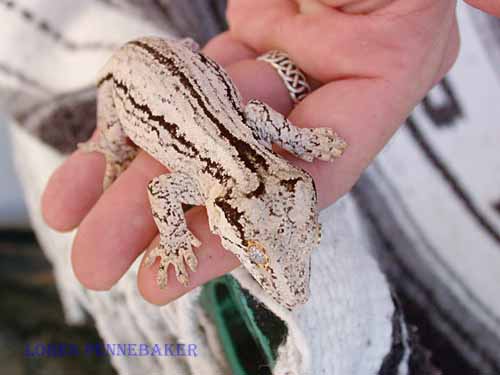
Photo by Loren Pennebaker
Never tightly grasp or restrain gargoyles. Allow them to sit in a hand.
Crickets are probably the best live prey for addressing the pet gargoyle’s protein needs. Offer them one to two times per week. The number of crickets to feed your gecko varies over time, but never exceed the amount that can be eaten during a two-day period. Remove uneaten crickets after two days. Offer only appropriately sized crickets. They should be no longer than the space between a gecko’s eyes.
The adage “you are what you eat” applies to geckos, too. Purchase crickets from high-quality sources, and take care to ensure they stay in optimal health until they are fed to the geckos. Crickets should be hydrated and fed a quality, high-protein diet at least 30 minutes before being offered to a gecko. Taking these steps increases the nutritional value of the crickets and decreases the possibility of parasite issues.
Gargoyle geckos enjoy several types of fruit, including peaches, apricots, bananas, mangos, strawberries, cherries and figs. Fresh fruit is preferred. For easier consumption, fruit can be puréed in a blender with a little water. My gargoyles generally seem to prefer peach-flavored mixes. I have also had great success with apricot-banana-strawberry mixes. Each gecko has its particular tastes, but a wide range of fruit mixes are possible.
Offering these fruit mixes helps keep geckos hydrated and begins to train them to look for food and water in dishes. Generally twice a week offer fruit mixes in shallow dishes easy for geckos to access. I use the plastic lids from calcium supplement jars, but many types of dishes will work.
Baby foods can also be offered, or they can be added to fresh fruit mixes for additional flavoring. Again, peach baby food has given me the best results, but I also have had success with apricot, banana, mango and several others. Using fruity baby food mixes is convenient and saves time, but they’re probably less healthy than offering fresh fruit.
I strongly recommend adding a commercial powdered diet, often available at pet stores, to fruit mixes. I’ve been using Allen Repashy’s powdered diets since 2003, and I’ve observed an increase in the overall health of my Rhacodactylus geckos. Before powdered diets were available, I added calcium or multivitamin supplements to the fruit mixes, but the supplements seemed to ruin the flavors, and my geckos often decreased their consumption of the mixes. This does not seem to be the case for the powdered diets unless an excessive amount is added. How much powdered diet is added depends on how much fruit mix is being prepared. I generally add only enough to make the mix slightly thick and brown. I often taste the mixes to help identify which flavor is preferred. Remove any uneaten food within 36 hours.
Many baby gargoyles might be reluctant to eat crickets during their first three months, and they rely exclusively on fruit mixes for nutrition. Using powdered diets in these cases is crucial to healthy growth and development.
Supplements Guard From Calcium Deficiencies
Because gargoyles appear to eat vertebrates in the wild, it is likely that they’re more susceptible to calcium deficiencies than other Rhacodactylus species. A lack of calcium can lead to nutritional secondary hyperthyroidism, and it’s probably the leading cause of mortality in gargoyle geckos. For this reason it’s extremely important to supplement the diet with powdered calcium, which can be purchased at most pet stores.
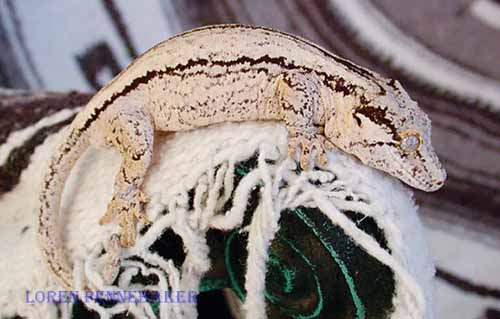
Photo by Loren Pennebaker
As gargoyle geckos mature, they become quite docile if gently handled on a regular basis during their first three years of life.
Dusting crickets with calcium powder is the primary method for calcium supplementation. Gather a number of crickets, place them in a large plastic container, sprinkle powdered calcium over them, and then gently shake the container to evenly distribute the powder until crickets appear slightly dusted. I lightly coat crickets with calcium each time they’re fed to the gargoyles.
A powdered multivitamin supplement is also necessary, but it isn’t as crucial as the calcium. Administer it in the same way as the calcium powder. I coat crickets with powdered multivitamins one to two times per month.
Read More
Which Gecko Species Is Right For You?
If a commercial powdered diet is offered, which I highly recommend, calcium and multivitamin supplementation becomes less critical. Some breeders successfully keep gargoyles exclusively on commercial diets and do not supplement at all. Even when offering commercial diets, I dust crickets with calcium at each feeding, and I dust them with multivitamins once every eight weeks. After six years of following this regimen, I have not noticed any deleterious effects.
As gargoyle geckos mature, they become quite docile if gently handled on a regular basis during their first three years of life. I have a 9-year-old male that calmly rests on my lap or shoulder for 30 minutes at a time. His calm demeanor makes him ideal for educational displays and public handling where tolerating groups of excited kids is crucial. Follow the guidelines below, and you’ll be on your way to a calm gecko of your own.
Gargoyle Gecko Tips
- Never tightly grasp or restrain gargoyles. Allow them to sit in a hand.
- Be prepared for a gecko to jump in a forward direction. Gargoyles appear to be hard-wired to jump as a defense mechanism. For this reason, I recommend remaining seated as much as possible while handling these geckos, so their fall is shorter. It’s also advisable to handle them in areas where carpet, or any type of padding, can soften their fall. To keep a gargoyle from jumping from my hand, I often place my other hand in front of it. This move discourages them and provides additional space for them to move. Biting and vocalizing their protests appear to be their final resort.
- Be patient. After a gargoyle grows accustomed to being handled, it will jump less and remain still for longer periods of time. This trend tends to continue as the gecko gets older, and eventually it becomes docile and easy to handle.
- Bear in mind that gargoyle geckos might tolerate handling, but they don’t necessarily enjoy it. To avoid undue stress, briefly handle babies and juveniles no more than once or twice a week. Limit handling of older gargoyles to five- to 10-minute sessions a couple times a week until they demonstrate that they can tolerate longer sessions.
Sturdy Lizards
Overall, gargoyle geckos make exceptional pets. They tend to be extremely hardy, and it’s likely that gargoyles will increase in popularity as more crested gecko owners and reptile enthusiasts discover them.
LOREN PENNEBAKER began keeping reptiles in 1984 and has since kept or bred nearly 100 species. Owner of Sundial Reptile, he purchased his first pair of gargoyle geckos in 2000 and has successfully produced babies for the past seven years.


